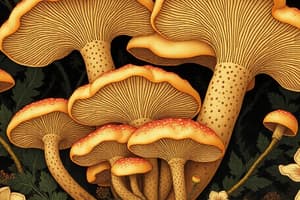Podcast
Questions and Answers
What is one of the main body parts of fungi responsible for absorbing nutrients?
What is one of the main body parts of fungi responsible for absorbing nutrients?
- Reproductive structure
- Hypha
- Mycelium (correct)
- Spore
Which ecological role is primarily associated with fungi?
Which ecological role is primarily associated with fungi?
- Decomposers (correct)
- Producers
- Predators
- Consumers
What structure do fungi use to reproduce?
What structure do fungi use to reproduce?
- Mycelium
- Hypha
- Spore (correct)
- Turgor
What allows fungi to break down complex organic materials?
What allows fungi to break down complex organic materials?
How do fungi primarily maintain their turgor pressure?
How do fungi primarily maintain their turgor pressure?
What is the primary structure formed by a network of hyphae?
What is the primary structure formed by a network of hyphae?
What are the different ways fungi can reproduce?
What are the different ways fungi can reproduce?
Which of the following is NOT an ecological role of fungi?
Which of the following is NOT an ecological role of fungi?
How do fungi primarily grow in terms of their structure?
How do fungi primarily grow in terms of their structure?
What type of structure are fungi generally considered?
What type of structure are fungi generally considered?
What role do hyphae play in the growth of fungi?
What role do hyphae play in the growth of fungi?
How do fungi transport resources across large distances?
How do fungi transport resources across large distances?
What is the main ecological role of mycelium in fungi?
What is the main ecological role of mycelium in fungi?
Which of the following best describes the fungus known as Cordyceps unilateralis?
Which of the following best describes the fungus known as Cordyceps unilateralis?
What adaptation helps hyphae respond quickly to their environment?
What adaptation helps hyphae respond quickly to their environment?
What is the primary method of dispersal for fungi?
What is the primary method of dispersal for fungi?
What is the nature of fungal spores?
What is the nature of fungal spores?
What happens when a fungal spore germinates?
What happens when a fungal spore germinates?
Which of the following is true about human fungal infections?
Which of the following is true about human fungal infections?
What characteristic defines a plant pathogen?
What characteristic defines a plant pathogen?
What is the ploidy level of fungal spores?
What is the ploidy level of fungal spores?
Which of the following statements is incorrect regarding fungal infections?
Which of the following statements is incorrect regarding fungal infections?
What role do microscopic spores play in fungi?
What role do microscopic spores play in fungi?
What characteristic differentiates endomycorrhiza from ectomycorrhizae?
What characteristic differentiates endomycorrhiza from ectomycorrhizae?
Which organisms are commonly involved in lichens?
Which organisms are commonly involved in lichens?
What role do lichens play in their ecosystems?
What role do lichens play in their ecosystems?
What is a feature of secondary symbiosis?
What is a feature of secondary symbiosis?
What type of cells do heterotrophic eukaryotes possess?
What type of cells do heterotrophic eukaryotes possess?
Which of the following best describes the nutrients exchanged in endomycorrhizae?
Which of the following best describes the nutrients exchanged in endomycorrhizae?
Which of the following is a method used by heterotrophic eukaryotes to obtain nutrition?
Which of the following is a method used by heterotrophic eukaryotes to obtain nutrition?
Which type of algae are considered primary products of primary endosymbiosis?
Which type of algae are considered primary products of primary endosymbiosis?
Which substance do heterotrophic eukaryotes store in a manner similar to animals?
Which substance do heterotrophic eukaryotes store in a manner similar to animals?
What distinguishes ectomycorrhizae from other types of mycorrhizae?
What distinguishes ectomycorrhizae from other types of mycorrhizae?
How do heterotrophic eukaryotes redistribute pressure and nutrients?
How do heterotrophic eukaryotes redistribute pressure and nutrients?
What is often used as evidence for the evolutionary relationship between algae and their symbiotic partners?
What is often used as evidence for the evolutionary relationship between algae and their symbiotic partners?
Which type of mycorrhizae typically leads to nutrient exchange occurring via the cytoplasm?
Which type of mycorrhizae typically leads to nutrient exchange occurring via the cytoplasm?
What characteristic shape do heterotrophic eukaryotes exhibit?
What characteristic shape do heterotrophic eukaryotes exhibit?
Which statement is true regarding primary endosymbiosis?
Which statement is true regarding primary endosymbiosis?
What type of organisms are considered heterotrophic eukaryotes?
What type of organisms are considered heterotrophic eukaryotes?
What does the term 'absorptive nutrition' refer to in heterotrophic eukaryotes?
What does the term 'absorptive nutrition' refer to in heterotrophic eukaryotes?
Why is cytoplasmic streaming important for heterotrophic eukaryotes?
Why is cytoplasmic streaming important for heterotrophic eukaryotes?
Flashcards
Heterotrophic Eukaryotes
Heterotrophic Eukaryotes
Organisms that obtain their nutrients by consuming other organisms. They cannot produce their own food like plants.
Growth in Heterotrophic Eukaryotes
Growth in Heterotrophic Eukaryotes
The process of increasing in size and complexity. Heterotrophic eukaryotes can grow in size and number of cells, becoming larger and more complex.
Unicellular/Multicellular
Unicellular/Multicellular
Heterotrophic eukaryotes can be either single-celled (unicellular) or made up of many cells (multicellular).
Shape Changes
Shape Changes
Signup and view all the flashcards
Chitin-rich Cells
Chitin-rich Cells
Signup and view all the flashcards
Glycogen Storage
Glycogen Storage
Signup and view all the flashcards
Cytoplasm
Cytoplasm
Signup and view all the flashcards
Absorptive Nutrition
Absorptive Nutrition
Signup and view all the flashcards
Hypha
Hypha
Signup and view all the flashcards
Mycelium
Mycelium
Signup and view all the flashcards
Fungal Reproduction
Fungal Reproduction
Signup and view all the flashcards
Ecological Roles of Fungi
Ecological Roles of Fungi
Signup and view all the flashcards
Basic Structure of Fungi
Basic Structure of Fungi
Signup and view all the flashcards
What is mycelium?
What is mycelium?
Signup and view all the flashcards
How does mycelium spread?
How does mycelium spread?
Signup and view all the flashcards
What are hyphae?
What are hyphae?
Signup and view all the flashcards
How do hyphae transport resources?
How do hyphae transport resources?
Signup and view all the flashcards
What are fungi?
What are fungi?
Signup and view all the flashcards
Fungal Spore
Fungal Spore
Signup and view all the flashcards
Spore Germination
Spore Germination
Signup and view all the flashcards
Plant Pathogen
Plant Pathogen
Signup and view all the flashcards
Chestnut Blight
Chestnut Blight
Signup and view all the flashcards
Human Fungal Infections
Human Fungal Infections
Signup and view all the flashcards
Eukaryote
Eukaryote
Signup and view all the flashcards
Heterotrophic
Heterotrophic
Signup and view all the flashcards
Spore
Spore
Signup and view all the flashcards
Reproductive Structure
Reproductive Structure
Signup and view all the flashcards
Decomposers
Decomposers
Signup and view all the flashcards
Endomycorrhizae
Endomycorrhizae
Signup and view all the flashcards
Ectomycorrhizae
Ectomycorrhizae
Signup and view all the flashcards
Endosymbiosis
Endosymbiosis
Signup and view all the flashcards
Lichen
Lichen
Signup and view all the flashcards
Evidence for endosymbiosis
Evidence for endosymbiosis
Signup and view all the flashcards
Nutrient Exchange in Mycorrhizae
Nutrient Exchange in Mycorrhizae
Signup and view all the flashcards
Ecological Importance of Lichen
Ecological Importance of Lichen
Signup and view all the flashcards
Evolution of Chloroplasts and Mitochondria
Evolution of Chloroplasts and Mitochondria
Signup and view all the flashcards
Growth in Unicellular Organisms
Growth in Unicellular Organisms
Signup and view all the flashcards
Autotrophs vs.Heterotrophs
Autotrophs vs.Heterotrophs
Signup and view all the flashcards
Study Notes
Oxygenic Photosynthesis
- Carbon dioxide + water creates sugar and oxygen
- Most life forms on Earth rely on this process
- Heterotrophs depend on autotrophs or other heterotrophs
Evolution of Eukaryotes
- Eukaryotes have organelles with specific functions
- Organelles evolved from cell membranes or other life forms (endosymbionts) that benefited from living inside another cell
Endosymbiotic Theory and Eukaryotic Cell Evolution
- Eukaryotic cells evolved from prokaryotes through the engulfing of other organisms
- Mitochondria and chloroplasts are thought to have originated from bacteria through endosymbiosis
Lecture 26: Fungi
- Fungi are more closely related to animals than plants
- Evolved in freshwater environments
- Evolved cell walls and became saprophytes (absorbing dissolved organic matter)
- Crucial roles as decomposers, pathogens, and symbionts, especially with plants
Fungal Diversity
- Multiple origins of multicellularity from various lineages (not just plants and animals)
- Various fungal phyla exist, including examples like Cryptomycetes, Microsporidians, Chytrids, Zoopagomycetes, Mucoromycetes, Ascomycetes, and Basidiomycetes
Why Study Fungi?
- Key roles in terrestrialization
- Agricultural and food biotechnology
- Human health
Characteristics of Fungi
- Heterotrophic eukaryotes (can be unicellular or multicellular)
- Cell walls rich in chitin
- Store carbon as glycogen
- Absorptive nutrition (secrete enzymes to digest food externally)
- Multicellular fungi are non-motile and filamentous
- Reproduce through spores (sexually or asexually)
- Play ecological roles (decomposers, parasites, mutualists)
Fungal Structure
- Mycelium (network of hyphae)
- Hyphae (single filaments)
- Spores
- Reproductive structures
Fungal Nutrition/Growth
- Saprotrophic, parasitic, and mutualistic lifestyles exist
- Three main forms (crustose, fruticose, foliose)
Ecological Roles of Fungi:
- Decomposers: Break down organic matter
- Pathogens: Cause fungal infections
- Symbionts: Mutualistic partnerships with other organisms
Ecological Roles of Fungi - Pathogens
- Various fungal infections (mycoses) affect plants and humans
- Some fungi cause significant human health issues, especially in immunocompromised individuals
Ecological Roles of Fungi - Symbionts
- Fungi form mutualistic partnerships with many other organisms (like plants)
Lecture 27: Algae
- Algae are photosynthetic organisms, a group of various organisms, not necessarily closely related or a single lineage
- Some are single-celled, some are multicellular.
- They are crucial because they perform photosynthesis, which generates oxygen and serves as a base of many food chains
Endosymbiosis and Algal Groups
- Endosymbiosis (one organism living inside another, creating a beneficial partnership) is important for the evolution of chloroplasts
- Algae are made up of multiple evolutionary lineages; photosynthesis evolved different times in unrelated lineages.
- Primary and secondary endosymbiosis are how chloroplasts formed in algae
Studying That Suits You
Use AI to generate personalized quizzes and flashcards to suit your learning preferences.




